chow and rice - 1982 - qualified audit opinions and auditor switching
Bạn đang xem bản rút gọn của tài liệu. Xem và tải ngay bản đầy đủ của tài liệu tại đây (1.42 MB, 11 trang )
Qualified Audit Opinions and Auditor Switching
Author(s): Chee W. Chow and Steven J. Rice
Source:
The Accounting Review,
Vol. 57, No. 2 (Apr., 1982), pp. 326-335
Published by: American Accounting Association
Stable URL: .
Accessed: 28/04/2014 23:50
Your use of the JSTOR archive indicates your acceptance of the Terms & Conditions of Use, available at .
/> .
JSTOR is a not-for-profit service that helps scholars, researchers, and students discover, use, and build upon a wide range of
content in a trusted digital archive. We use information technology and tools to increase productivity and facilitate new forms
of scholarship. For more information about JSTOR, please contact
.
American Accounting Association is collaborating with JSTOR to digitize, preserve and extend access to The
Accounting Review.
This content downloaded from 128.252.88.241 on Mon, 28 Apr 2014 23:50:42 PM
All use subject to JSTOR Terms and Conditions
THE
ACCOUNTING
REVIEW
Vol. LVII,
No. 2
April
1982
NOTES
Qualified
Audit
Opinions
and
Auditor
Switching
Chee
W. Chow and Steven J. Rice
ABSTRACT:
This
study focuses
on the
influence
of
qualified opinions on auditor
switches. Results
from
a
random
sample
of
SEC-registrants support
the
contention
that
firms switch auditors more frequently after receiving qualified opinions. However, it was
not found
that firms that have
received qualified opinions
switch
systematically
to
audit
firms
with a
history of rendering proportionally
fewer
qualified opinions. Also,
limited
results suggest that qualified
firms which
switch auditors
do not tend
subsequently
to
receive more clean opinions.
I.
INTRODUCTION
LARGE-SCALE
auditing
scandals like
Continental
Vending, Equity
Fund-
ing, and National Student Market-
ing have focused the public's attention on
auditor "independence." Critics fre-
quently charge
that the
asymmetry of
power between
auditors and
managers
may seriously
weaken the
auditor's
ability
to exercise
freely
his
professional
judgment.
A
statement
by Sterling [1973,
p. 66]
is
representative:
The
major problem facing public account-
ing today
is
its lack
of power. First,
in
com-
paring
the
power or authority
to
the re-
sponsibility,
we
find
that the
responsibility
far
outweighs
the
authority.
The
public
ac-
countant
must
act
judicially but
he
has
not
been
given
the
power
to enforce his
rulings.
The
authority
is
lessened
further
by
the
existence
of
competition among accounting
firms.
Resignation from
an
engagement might
be
an
effective means
of enforcement if it
were not for the fact that
other firms may
take the
engagement and issue an opinion.
When
one considers the fact that ac-
countants
must
judge management, . .
.
[the
imbalance
between management's power and
the accountant's power] is not only un-
desirable,
it
is
intolerable.
The
auditor-client
relationship
has
also
been
a
concern of accounting policy
makers.
The AICPA
has
promulgated
voluminous guidelines
for
auditing
and
reporting procedures
and
commissioned
a
study
of auditor
responsibility.
The
SEC
has
been increasing
its
disclosure
requirements
for auditor-client
relation-
ships.'
Even the U.S.
Congress
has voiced
its
concern
for
auditor
"independence"
1
Examples
include
ASR
165
[SEC,
19741
and
ASR
194
[SEC,
1976].
The
authors
gratefully
acknowledge
the
assistance
of
Professors
John Chiu,
Jim Jiambalvo,
Robert
Bowen,
and
Jamie
Pratt.
Chee
W. Chow
is Lecturer
in
Account-
ing
and
Steven
J.
Rice
is
Assistant
Profes-
sor
of
Accounting,
both
at
the
University
of
Washington.
Manuscript
received
November
1980.
Revision
received
April
1981.
Accepted
May
1981.
326
This content downloaded from 128.252.88.241 on Mon, 28 Apr 2014 23:50:42 PM
All use subject to JSTOR Terms and Conditions
Chow
and
Rice
327
in the
Moss
Committee Report
[U.S.
House of
Representatives, 1976]
and the
Metcalf
Committee Staff
Report
[U.S.
Senate,
1976].
Policy makers
attach
importance
to
the ability
of managers
to
"shop"
for
auditors.
The concern
is
that
managers
can pressure auditors
into
giving
clean
opinions by
threatening
to
switch
to
a
new auditor.
It
is
argued
that
managers
wish
to avoid
qualified
opinions
because
they may
affect
(a)
the market
price
of
the firm's common stock
and
(b)
the
manager's
compensation.
Moreover,
the
manager
often
holds
some
of the firm's
shares
in
his
personal
portfolio
either
through open market
purchases
or
through stock
options granted
as
part
of
his
compensation.
Compensation
may
be tied to the
reported
earnings
and the
reliability
of those
reports comes
into
question
when
there is
a
qualification.
If
(a) qualified
opinions
are
seen
(by
man-
agers) to
reduce
security prices
and/or
manager
compensation
and
(b)
managers
control
the
auditor selection
decision,
then
we
should be able
to observe
that
qualified
opinions are
followed by
audi-
tor switches.
The
purpose
of this
paper
is
to
present
empirical
evidence
relating
to
the
following
four
questions
concerning
auditor
switching:
1.
Do
firms switch
auditors more
often
after
receiving
qualified
opinions
than after
receiving clean
opinions?
2.
Do auditors
differ
in
their
propen-
sity
to issue
qualified
opinions?
3.
If auditors
do
differ in their
pro-
pensity
to
issue
qualified
opinions,
do
firms
after
receiving
qualified
opinions switch to
auditors
issuing
proportionally
fewer qualified
opin-
ions?
4.
When firms
switch
auditors
after
receiving a
qualified opinion,
are
they more
likely
to receive
clean
opinions
the
following year?
Positive
answers to
these
questions
would
imply
that
firm
managements
may
use
auditor switches to
pressure
auditors
into
issuing
clean
opinions. Such evidence
could
prompt the
SEC
and/or
the FASB
to
further consider their
policies
regard-
ing
firms
changing
auditors.
We
present
our
analysis
as
follows: Section
II
reviews
some
prior research
regarding
auditor
switching.
Section
III
describes
our
data
collection
procedures
and
the tests
per-
formed.
We
draw
some
conclusions
in
Section
IV and discuss the
implications
of
our results
for
future research and
public
policy.
II.
SOME PREVIOUS PUBLISHED
STUDIES
ON
AUDITOR
SWITCHING
A number
of
authors have
discussed
the
role
of
accounting
disputes
in
firms'
choice of
auditors.2
However,
only
one
study
has
provided
systematic evidence
on this
issue.
Burton
and
Roberts
[1967]
examined 83
auditor switches
made
by
Fortune 500 firms
between
1952
and
1965.
Using
questionnaires
as their
primary
tool,
the
authors
determined that
ac-
counting
standards
disputes were
the
major
causes
for
only
six
switches. The
other
switches
were
related to
changes
in
management,
the
demand for
addi-
tional
services
or
needs
arising
out of
new
financing. This
led
Burton
and
Roberts
to
conclude
that
competition
among
audi-
tors
was
not
a
cause of
loose
application
of
accounting
standards.
This
conclusion
is
suspect
because
if
firms
switch
auditors
so as
to
gain more control
over
the con-
tents of
issued
financial
statements, it
is
not
in
the
firms'
own
interest
to
reveal
this
action
to
outsiders.
Further,
if
auditors
were
already forced
by
compe-
tition
to
apply loose
accounting stan-
dards,
firms would have
no need
to
2
Goldman
and
Barlev
[1974],
Nichols
and
Price
[1976],
Burton
and
Roberts
[1967],
and
Fried
and
Schiff
[1981
].
This content downloaded from 128.252.88.241 on Mon, 28 Apr 2014 23:50:42 PM
All use subject to JSTOR Terms and Conditions
328
The
Accounting
Review,
April
1982
switch auditors due to
accounting dis-
putes.
Even though the Burton
and Roberts
study fails to resolve whether
accounting
standards play a major
role in auditor
switching, it does identify
other variables,
such as management changes
and new
financing, which affect firms'
choice of
auditors.
These findings
are supported
by Carpenter
and
Strawser
[1971]
and a
study by
an
ad hoc committee
of the
AICPA [1971].
III.
DATA COLLECTION
AND TESTS
A. The
Association
Between
Qualified
Au-
dit
Opinions
and
Auditor
Switches
One
way
of
testing
whether
firms
switch auditors
after
receiving qualified
opinions would
be
to
classify
all
of
the
firms reporting to the public
over a given
time
period
into four
categories:
1.
Received a qualified
opinion and
switched auditors
subsequently,3
2.
Received
a
qualified
opinion
and
kept
the same
auditor,
3.
Received
a
clean
opinion
and
switched auditors
subsequently,
and
4.
Received
a
clean
opinion
and kept
the
same
auditor.
Then a
four-cell
contingency
table could
be
set
up
and tested
using
the
Chi-square
test
for
independence
of classification.
A
significant
value
for
Chi-square
would
mean
that
switching
was
not
independent
of
receiving
a
qualified
opinion.
Our data
were collected
from the 1973
and
1974 volumes
of the
Leasco
Disclo-
sure Journal.4
All
companies
that
had a
qualified opinion (excluding
consistency
exceptions)
in 1973 and
all
companies
that
changed
auditors
between
the 1973
and
1974
fiscal
year-ends
were
selected.
This
procedure yielded
a
count
for the
first three
of the
categories
listed above.
The count
for the fourth
category (clean
opinion
and did
not
switch)
was
arrived
at
indirectly by counting
the total
number
TABLE
1
THE
ASSOCIATION BETWEEN
QUALIFIED AUDIT
OPINIONS
AND
AUDITOR
SWITCHING
Qualified
Unqualified
Row
totals
(1)
(3)
Switched
141 277 418
(2)
(4)
Non switched
991
8,051
9,042
Column
totals
1,132
8,328
9,460
Actual
x2
(1 d.f.)=
196.81
Significant
x2 (1
d.f.)=6.635
for
o=0.0.
of
firms reporting and
subtracting the
total
of
the first three
categories. Table
1
shows the
contingency table
with the
count
for
each cell
and
the
results of
the
Chi-square
test
for
independence
of
While
this
overall test
provides
inter-
esting information,
it
ignores
the effect of
classification.
The
test
clearly supports
the notion
that
changing
auditors is not
independent
of
receiving a
qualified
audit
opinion.'
other variables
that
might
influence a
firm to
change auditors.
In order
to
address this
issue, we
collected
data for
various subsets of the firms in
Table
1.
For each
firm
in
a
subset, we
collected
additional
data
from the
Disclosure Jour-
nal on
several variables which had been
identified
in
previous
studies as related to
changing
auditors.6
The
following
vari-
ables
were
recorded
simply
as
being
3 We assume that, in
the absence of other causes, an
auditor switch due
to a qualified opinion will be made
during
the next
fiscal
year.
If
this is not true, the omission
of subsequent switches will
bias
results
against finding
a
significant
relationship.
4 The Disclosure
Journal includes
all firms that file
with the SEC.
To
allow
for the
possibility that
some firms
may
switch auditors
in
anticipation
of
a qualified opinion,
we reconstructed Table
1
by including
in
Cell
1 57
addi-
tional
firms
which
switched auditors
before
their 1973
fiscal year-end rather than
after.
The results were not
significantly altered.
6 Burton and Roberts
[1967 ], Carpenter
and Strawser
[1971],
and
AICPA
[1971].
This content downloaded from 128.252.88.241 on Mon, 28 Apr 2014 23:50:42 PM
All use subject to JSTOR Terms and Conditions
Chow and Rice
329
present
or not
present
for
each
firm
in
fiscal 1974:
a
management
change,
some
merger
activity,
new
financing,
an
ac-
counting
dispute
with
the
auditor,
and
any
other
item
identified
by
management
as the
reason for
changing
auditors.
Data
on the name of
the
auditor,
the
name of the
new auditor
(if
switched),
the
type
of
opinion,
the
industry
(three-
digit
SIC
code),
and
revenues
earned
in
1973
were also recorded.
The
approach to
forming
the
subsets
and
testing
them
was to
randomly
select
141 firms
from
cell
4
in
Table
1
(about
1.75
percent
of the total
cell
4
firms),
and
to
randomly
select the same
percentage
of
firms
from each of the
other
three
cells.7 This
sample
size was
considered
to
be small
enough
to
enable
us
to
gather
the
additional
information
needed
in a rea-
sonable amount
of time.
The same
per-
centage
in each cell
was used
in
order
to
preserve
the
proportions
that existed in
the
Leasco
population.
The
relation
of
these variables to
auditor
switching
was
tested
in
an
equation
of
the form
:8
S
=
a
+
bjQ
+
b2Mg +
b3Mr
+
b4N
+
b5X
(1)
where:
S=switched
auditors
(1)
or
did
not
switch
(0)
Q
=
received
a
qualified
opinion
(1)
or
unqualified (0)
Mg
=
management
change
took
place
(1)
or
did not
take
place
(0)
Mr
=
merger
activity
present (1)
or
not
present
(0)
N=new
financing
arranged
(1)
or
not
mentioned
(0)
X=
some reason
(other
than
those
above)
was
given
for
switching
(1)
or
no
other
reason
listed (0).
It
may
appear
that
ordinary
least
squares
(OLS)
would
be a
reasonable
tool
to
evaluate
Equation
(1).
However,
such
is
not the
case.
Theil
[1972,
sec.
12.5]
points
out that there
are
three
major
problems
with
OLS
when
the
dependent
variable
is
dichotomous.
First,
the
esti-
mating
equation
is
unbounded
and
there
is
no
guarantee
that
the
predicted
value
of
the
dependent
variable
(a
probability)
will be
in
the
(0,
1)
interval.
Second,
the
residuals
will
be
heteroscedastic
and
OLS
would
yield
inefficient
estimators.
Finally,
because
the
dependent
variable
is
dichotomous,
the
residuals
cannot
be
assumed
normal.
This
means
that the
typical
F
and
t
tests of
significance cannot
be
used.
We
also
rejected
multivariate
discrimi-
nant
analysis
(MDA)
because of
its
dis-
tributional
requirements.
Eisenbeis
[1977]
and
Ohlson
[1980] point
out
that
MDA
requires the
variance-covariance
matrices of
the
independent
variables to
be the
same
for
both
groups
(switched
and
non-switched). We
found that
this
does
not
hold
for our
sample.
Also,
MDA
assumes
normally
distributed
indepen-
dent
variables,
which
does not
hold for
our case.
Theil
[1971]
and
McFadden
[1973]
point
out
that
conditional
logit
analysis
essentially
avoids
all of
the
problems
discussed
above.
This is
a
maximum-
likelihood
estimation
procedure
which
applies
a
transformation to
the
dependent
variable.
McFadden
[1973,
p.
119]
indi-
cates
that
this
method
yields
estimators
that
are
asymptotically
efficient
and
normally
distributed.
He
also
presents
simulation
results
which
suggest
that
the
approximation is
reasonably
good
even
in
quite
small
samples.
This
means
that
one
can
construct
approximate
large-
sample
confidence
bounds
and
tests
of
7
The
141
firms
represented
an
arbitrary
number cor-
responding
to the
number
of
firms in
cell 1.
8
We did not
include
"accounting
dispute"
as an
in-
dependent
variable.
The
SEC 8-K
requirement
of
ac-
counting-dispute
disclosure
applies
only
to firms
that
switched
auditors. Our
data
source did
not
reveal
whether
some
firms that
did
not
switch
auditors
also
had
had
accounting
disputes.
This content downloaded from 128.252.88.241 on Mon, 28 Apr 2014 23:50:42 PM
All use subject to JSTOR Terms and Conditions
330
The Accounting
Review,
April
1982
TABLE
2
VARIABLES
RELATED
TO
AUDITOR
SWITCHING
Asymptotic
Variable
Coefficient
t-score*
Qualified
1.5859
2.6589*
Management
Change
-25.9250
-0.0006
Merger
-
0.5236
-0.4872
New Financing
0.5078
0.6884
Other
-26.7340
-0.0004
Intercept
-
3.1911
-8.2712
Estimated
R2
=
.1042
X2
(5 d.f.)
=9.242
t-score
of
1.96
=significance
level
of .05 and
t-score of
2.33
=significance
level
of .0
1.
hypotheses
for
parameters.
Because
of
this, we
chose
a
conditional
logit analysis
for
Equation (1).9
The
results
appear
in
Table
2.
McKelvey
and Zavoina
[1975]
show
that
the
significance
of the
logit
model
can
be tested
by
taking
-2
times
the
log-
likelihood
ratio.
The
resulting
statistic
is
distributed
as
a
Chi-square
with
degrees
of
freedom
equal
to
the
number of
inde-
pendent
variables.
This statistic
is
9.242
for
our model
and
is
significant
at
the
.1
level.
The
t-scores
in Table
2 show
clearly
that
qualification
is the
only significant
variable
in
explaining
switching.
How-
ever, given
the
independent
variables
used,
the
coefficients
may
have
been
biased by
multicollinearity.
We
did not
conduct
a formal
test
for this. Table
3
presents
the correlations
among
the
inde-
pendent
variables.
Even
though
a few
are
statistically
significant,
none of
the
values
seems
high
enough
to
cause
concern)'0
B.
Difference
Among
Auditors'
Percent-
ages
of Qualified
Opinions
An
incentive
for
switching
auditors
after
receiving
a
qualified
opinion
can
be
TABLE
3
CORRELATIONS
AMONG
THE
INDEPENDENT
VARIABLES
(Numbers
in
Parenthesis
are
significance
levels.)
Q
Mg
Mr
N
X
Q
1.0
Mg
.177
1.0
(.023)
Mr
066
.030
1.0
(.373)
(.602)
N
.190
.047
091
1.0
(.016)
(.522)
(.204)
X
.260
.246 043
.0 85
1.0
(.001)
(.001)
(.611) (.250)
inferred
if there
is a different "tendency
to
qualify"
across
auditors.
A
proxy
for
this tendency
may
be
the observed
per-
centage
of
qualified
opinions
given
by
an
auditor.
However,
a
raw
calculation
of
this
percentage
is not sufficient.
There
is
much
evidence
that auditors
specialize
I
Theil
[19711
also
suggests
probit
analysis
as an
ap-
propriate
tool.
We conducted
the same analysis
with
probit
and
obtained
almost
indistinguishable
results
from
the
logit
analysis.
10
Farrar
and
Glauber
[1967]
provides
a
detailed
explanation
of tests
for
multicollinearity.
Kmenta
[1971]
points
out
that
some
degree
of
multicollinearity
almost
always
exists,
but the
point
at which
it
becomes
"harmful"
has
never been
satisfactorily
determined.
According
to one
criterion,
if the
overall equation
is
significant,
but
none
of
the
t
statistics
for
the
regression
coefficients
(other
than
the regression
constant)
is
sig-
nificant,
then multicollinearity
is regarded
as
harmful.
According
to
this
criterion,
we
do
not have
"harmful"
multicollinearity.
Further,
several
statisticians
who
examined
our data unanimously
declared
that
the
num-
bers
were
so
low
that
multicollinearity
was
not
likely
to
be
a
problem.
We tried
to assess
the
potential
sig-
nificance
of the
multicollinearity
problem
by
generating
estimate
Equation
1
three
more
times.
Merger
had
a
significant
coefficient
in
one
of the
new regressions.
Otherwise
the
results
were unchanged.
This
suggests
that
multicollinearity
is not
a significant
problem
in
our
study.
This content downloaded from 128.252.88.241 on Mon, 28 Apr 2014 23:50:42 PM
All use subject to JSTOR Terms and Conditions
Chow and Rice
331
by
client
size
and
industry.
"
If
operating
conditions, legal
constraints,
and firm
characteristics
were
to differ
across
indus-
tries,
this
could
cause
observed
differ-
ences
in the
percentages
of
qualified
opinions
across auditors
which
really
reflect industry
differences. Indeed,
War-
ren [1975,
1980] reports
a
significant
relationship
between
industry class,
firm
size,
and
the
receipt
of a
qualified
opin-
ion. Warren
[1980]
also finds
auditor
identity
to be
significantly
related to
qualified opinions.
However,
he does
not
investigate
which
auditors
are
more
likely
to
issue
such opinions.
More
im-
portant,
Warren uses the parametric
analysis
of variance
(ANOVA)
to
analyze
his data.
Unfortunately,
the
dependent
variable in his
studies is a dichotomous
variable, which
seriously violates
the
basic
ANOVA
assumption
of
normally
distributed
dependent variables,
and
casts
doubt
on his
results.'2
Shank
and
Murdock
[1978]
also
in-
vestigate
the differences
among
auditors'
percentages of qualified
opinions. Unlike
Warren, they do
not find auditors
to be
significantly different
after accounting
for
systematic
risk. Also, they do not
find
either
size
or
industry to have significant
explanatory power
for the
incidence
of
qualified opinions.
Shank and Murdock
apparently also
use ANOVA on
a di-
chotomous
dependent
variable. If
so,
their
results suffer
from the same
prob-
lems
as Warren
[1975, 1980]. In any
case,
the
divergent
results
obtained by
these
researchers
suggest
the need for further
investigation.
To
take into account
the dichotomous
nature of the
dependent variable,
the
approach
used
for
testing Question
II
was
again
a
logit
analysis,
with
qualifica-
tion
as
the
dependent
variable and size,
industry,
and auditor
as
the independent
variables
in a
linear equation. Size
was
measured by revenues earned in 1973.
The
industry was classified as one of
seven, depending
on the
three-digit SIC
code as follows :13
0-149 Mining
200-399 Manufacturing
400-499
Transportation
and
public
utilities
500-519
Wholesale trade
520-599
Retail trade
600-699
Finance, insurance,
real es-
tate
700-899
Services
The
auditor was
classified as one of
nine:
the
Big Eight
firms
and all
others.
In
order to
have
enough
data
points,
141
firms were randomly selected
from cells
2, 3,
and
4
to match
the
number
of
firms
which comprise
the whole
population
of
cell
1
in
Table
1.
Thus,
the
analysis
was
run on 564
firms
with
15
independent
variables:
size,
six
industry
class
dummy
variables,
and
eight
auditor
dummy
variables.
The effect of
the
service
indus-
try and
"other"
auditors
are
included
in
the
intercept.
The
results
are
reported
in
Table
4.
The
Chi-square
for
this model is sig-
nificant at the .001 level. Of the inde-
pendent variables,
size
is significantly
and
negatively
related to
qualifications.
Also, significant industry effects exist for
transportation/public utilities, retail, and
perhaps
also
mining. Having taken into
I
IZeff and
Fossum
[1967]
and Rhode,
Whitsell, and
Kelsey [1974]
report
such
evidence.
Another
factor
which may limit
the
usefulness
of the
"observed
per-
centage qualified"
proxy is
potential
auditor
specializa-
tion
by
auditor
quality
and self-selection
by audit
clients.
Chow and Rice
[1981 ]
provide
a
discussion of
this
issue.
12
A
detailed discussion
of
ANOVA
and its
assump-
tions is
available in
Neter and
Wasserman [1974].
13
With the
exception
of
the
mining
industry,
these
industry
definitions are
identical to
Warren's
[1975,
1980]. Our
definition
of the
mining
industry
is
more
en-
compassing
than Warren's.
However,
only
one
firm's
in-
dustry
class
was affected
by
this difference in
definition.
This content downloaded from 128.252.88.241 on Mon, 28 Apr 2014 23:50:42 PM
All use subject to JSTOR Terms and Conditions
332
The
Accounting Review, April
1982
TABLE
4
VARIABLES
RELATED
TO
RECEIPT
OF
A
QUALIFIED
OPINION
Asymptotic
Variable
Coefficient
t-score*
Size
-
.0032
-
3.0679*
Mining
.8792
1.8596
Manufacturing
.2197
.7941
Transportation/public
utilities
-1.0571
-2.8288*
Wholesale
trade
.6020
1.2078
Retail trade
-
.9179
-2.2356*
Finance,
insurance,
real
estate
- .0886
-
.3060
Arthur Andersen
& Co.
.0679
.2181
Arthur Young
&
Company
1.1487
2.5913*
Coopers
&
Lybrand
.7796
1.9567*
Deloitte
Haskins &
Sells
.1759
.4397
Ernst & Whinney
.7068
1.8960
Peat,
Marwick,
Mitchell
&
Co.
.4990
1.8299
Price
Waterhouse &
Co.
.0357
.0899
Touche
Ross
& Co.
1.0897
2.4863*
Intercept
-
.0908
-
.3702
Estimated
R2
=.1745
X2
(15
d.f.)=79.1398
*
t-score
of
1.96=
significance
level of .05 and
t-score
of
2.33
=significance
level
of
.01.
account
size and
industry,
three
auditors
still
have
significantly
positive
coeffi-
cients:
Arthur
Young
&
Company,
Coopers
&
Lybrand,
and
Touche
Ross
&
Co.
These
auditors
can be
interpreted
as
having
a
higher
tendency
to
qualify,
ceteris
paribus.
Again,
multicollinearity
does
not
appear
to
be
of
major
concern.
Of
the 105
pairwise
correlations
among
the
independent
variables,
one
was
slightly
above
.3
(significant
beyond
.00
1)
and
two
were
between
.2
(significant
beyond
.001)
and
.3.
The
rest were
all
much
smaller
(and
usually
insignificant).
Thus,
Question
II
has
been
answered
affirmatively;
there
may
be
some
in-
centive
to switch
auditors
in
seeking
clean
opinions.
C.
The
Direction
of Auditor
Switches
by
Qualified
Firms
Can it
be
shown
that
firms,
after
re-
ceiving
qualified
opinions,
tend to
switch
more
away
from
Arthur Young
&
Com-
pany,
Coopers
& Lybrand,
and
Touche
Ross & Co.?
To
test
this question,
a
Chi-
square
analysis
was
run on
the
141 firms
which
received
qualified
opinions
and
then switched-
auditors.
The
three signifi-
cant auditors
in
Table
4 were
classed
as
High
Tendency
(HT)
and the
others
were
classed
as Lower
Tendency
(LT).
Table
5
shows
the
results.
The numbers
in
paren-
theses
below the
actual
frequencies
repre-
sent
the
expected
frequencies
of
those
cells
if there were
no
relationship
between
old and
new
auditor
in
terms
of
tendency
to
qualify.
If
the
answer
to
Question
III
is
positive,
we
would
expect
more
than
120
firms
to
have switched
from
HT
to
LT
(cell
2)
and
less than
five
to have
switched from HT
to
HT (cell
4).
Clearly,
there is no significant
relationship
here,
and the Chi-square
value
of
.2561 (sig-
nificance=.6128)
bears
this
out.'4
D.
Auditor
Switches
and
Subsequent
Audit
Opinions
The
last
question
was
whether
a switch
in
auditors
actually
results
in
receiving
a
clean
opinion.
To
answer
this
question
properly,
it would
be
necessary
to hold
other
factors,
such
as the
firm's
financial
condition,
constant.
We used
the
quali-
fied-and-no-switch group
as
a
control.
As
we
discuss later,
this
may
not
provide
14
We
repeated
this
analysis
by
including
in the
HT
group
auditors
from
Table
4
whose
t-scores
were
close to
significance,
i.e.,
Ernst
&
Whinney
and
Peat,
Marwick,
Mitchell
& Co. The results
were
quite
similar.
We also
repeated
this
analysis
by re-grouping
the data
into
HT
and
LT
groups
based
on
"folklore"
rather than
on
empirical
data.
"Folklore"
might
indicate
that in
the
minds
of
management
a certain
group
of
auditors, say,
non-Big
Eight
auditors,
had
a
lower
tendency
to
qualify.
We
investigated
this
using
a
Big
Eight
versus
non-Big
Eight
dichotomy
and
again
found
no
significant
rela-
tionship.
This content downloaded from 128.252.88.241 on Mon, 28 Apr 2014 23:50:42 PM
All use subject to JSTOR Terms and Conditions
Chow
and
Rice
333
TABLE
5
DIRECTION
OF AUDITOR
SWITCHING
BY
QUALIFIED
FIRMS
New
Auditor
LT
HT
Row
totals
(1)
(3)
LT
96
20
116
(95)
(21)
Old
Auditor
(2) (4)
HT
19
6
25
(20)
(5)
Column totals
115
26
141
X2
(1
d.f.)=
2561
adequate
control
for
other
variables.
Thus,
our
results can
only
be
viewed
as a
preliminary look at
this
question.
Recall that
in
testing
Question
II
we
drew a
sample
of 141
firms for
each
cell
and
looked
up
the
auditor,
size,
industry,
etc.
for
fiscal 1973.
Now,
for each
firm in
the
qualified-and-switched
and the
quali-
fied-and-no-switch
cells,
we
collected
data on
the
audit
opinion for
fiscal 1974.
Using
both the
Disclosure
Journal
and
microfiche
copies of 10-K
reports,
we
located
the
1974
audit
opinion
for
all
141
firms
in
the
qualified-and-no-switch
group and
for 132
firms
in
the
qualified-
and-switched
group.
A
Chi-square
test
was
applied
to
these
firms
to
determine
if
a
relationship
exists
between
auditor
switching
and
the
subsequent
audit
opin-
ion.
Table 6
reports
these
results.
If
switching
helps
reduce
the
incidence
of
qualifications,
we
would
expect fewer
than
98
firms in
cell
1
and
more than
34
firms in
cell
3.
Just
the
opposite is
the
case.
Although
the
Chi-square value
of
1.92
was
not
significant
at the
.1
level,
the
data
suggest
that
those
firms
that
did
not
switch
tended to
get
more
clean
opinions
TABLE
6
AUDITOR SWITCHES AND
SUBSEQUENT
AUDIT
OPINIONS
Type
of
Opinion
in Year
Following
Qualification
Not
Qualified
Qualified
Row
totals
(1) (3)
Switched 103 29
132
(98)
(34)
(2)
(4)
No
switch 100
41
141
(105)
(36)
Column totals
203
70
273
Actual
X2
(1
d.f.)
=
1.924.
Significant x2 (1
d.f.)
=
2.71
for
a
=
.10.
in the
following
year
than
those firms that
switched.
1
One
possible
reason for this
tendency
is the
failure
to
control for
the
effects
of
extraneous
variables like
financial
con-
dition. But
perhaps
a more basic
issue is
involved: if
a firm
knew that
the
reason
for the
qualified
opinion
would
not
exist
the
following
year,
it
would not
have
an
incentive
to
switch
auditors
for
this
rea-
son.
Thus,
the
qualified-and-no-switch
group
might
be
expected
to
have
a
higher
percentage
of
clean
opinions
in
the
fol-
lowing
year.
Another
possible
explana-
tion
relates to the
type
of
qualification.
If
managers
view
certain
types
of
qualified
opinions as
"benign,"
again
there
would
be no
incentive to
switch
auditors. We
did
not
pursue
this
potential
explanation
with
15
We could
not
find
1974
audit
opinions
for nine of
the
firms
in
the
qualified-and-switched
group.
In
order
to
evaluate the
potential
impact
of
these nine
firms on
the
Chi-square
test,
we
did
the
test
assuming
that all nine
firms
received
qualified
opinions
in
1974.
The
Chi-
square
value was
2.74
which
was
significant at
the .10
level.
We
did the
test
again
assuming
that
all
nine
firms
received clean
opinions in
1974.
There
was
no
significant
relationship.
This content downloaded from 128.252.88.241 on Mon, 28 Apr 2014 23:50:42 PM
All use subject to JSTOR Terms and Conditions
334
The
Accounting
Review,
April
1982
our
data.
Our
preliminary
results sug-
gest,
however, that
further
research
is
warranted.
IV.
CONCLUSIONS AND
IMPLICATIONS
Our
results
support
the
contention
that
firms
tend to
switch
auditors
after re-
ceiving a
qualified
opinion.
The
incentive
for such
switching
may exist
due
to
observed
differences
among
auditors'
percentages of
qualified
opinions
issued.
However,
our
analysis
of
switching
firms
does
not indicate
that
qualified
firms
tend to
switch to
lower
percentage-quali-
fied
auditors.
We
also
find
that
firms
that
switched
auditors after a
qualified
opin-
ion,
compared
to
the
qualified firms
that
did
not
switch,
are
not more
likely
to
receive a clean
opinion
the
following
year. The
evidence
tends to
support the
opposite.
While
our results are
prelimi-
nary
and
based
on
a limited
time
span,
they
suggest
that
further
work
in
this area
may
be
fruitful.
Even
if
our
major
results are
replicated
in
more extensive
studies,
it does
not
necessarily
imply
that
there
is
cause for
concern over
auditor lack of
indepen-
dence. Recently, Jensen and Meckling
[1976], Watts [1977], Smith and Warner
[1979], and others have explored the role
of external auditing
in
business firms.
They postulate that the manager can
benefit from
letting shareholders and
bondholders
monitor
his allocation
of
the
firm's
resources.
The
choice
of
an
external auditor
is
part
of this
monitoring
contract, and
it
is in
the
manager's self-
interest to select an
auditor
who has es-
tablished
a
reputation for integrity. The
implication
of this
analysis is that when a
firm manager chooses (or switches) an
auditor,
he
is
guided by
the
expected
reactions from shareholders
and
bond-
holders.
Thus,
auditor
switching per se,
regardless of whether
it
is
associated with
a
qualified opinion, may
not be
contrary
to
investors' interests.
We
believe
that future
research
should
explore
the
roles
played by management
and
external
investors
in the auditor
selection decision.
When such
evidence
is combined with findings
on the extent
of
auditor
switching,
we
will have
a
better
basis
to determine the
need for
regulatory
intervention
in this area
of
accounting.
REFERENCES
AICPA, Report of the Ad Hoc Committee
on Auditor Displacement, summarized
in C. Carpenter and
R. Strawser, "Displacement of Auditors
When Clients Go Public," Journal of
Accountancy (June 1971),
pp. 55-58.
Burton,
J.
C., and
W.
Roberts,
"A
Study of Auditor Changes," Journal of
Accountancy (April 1967),
pp. 31-36.
Carpenter,
C.
G.,
and R. H.
Strawser, "Displacement
of
Auditors
When
Clients Go
Public," Journal of
Accountancy (June 1971), pp.
55-58.
Chow, C.,
and
S.
Rice, "Qualified
Audit
Opinions
and the Measurement of
Auditing
Standard
Uni-
formity," Unpublished manuscript,
University
of
Washington (May 1981).
Eisenbeis, R. A., "Pitfalls
in
the Application
of Discriminant Analysis
in
Business, Finance, and Eco-
nomics," Journal of Finance (June
1977), pp. 875-900.
Farrar, D.,
and R.
Glauber,
"Multicollinearity
in
Regression Analysis: The
Problem Revisited,"
Review
of
Economics and Statistics
(February
1967), pp.
92-107.
Fried, D.,
and
A.
Schiff,
"CPA Switches and Associated
Market
Reactions,"
THE ACCOUNTING
REVIEW
(April 1981), pp.
326-341.
Goldman, A., and
B.
Barlev,
"The
Auditor-Firm
Conflict of Interests: Its
Implications
for
Independence,"
THE ACCOUNTING
REVIEW
(October
1974), pp.
707-718.
Jensen, M., and
W.
H. Meckling,
"Theory of the Firm: Managerial Behavior,
Agency
Costs and Owner-
ship Structure,"
Journal
of
Financial
Economics (October 1976), pp. 305-360.
This content downloaded from 128.252.88.241 on Mon, 28 Apr 2014 23:50:42 PM
All use subject to JSTOR Terms and Conditions
Chow
and
Rice
335
Kmenta, J.,
Elements
of
Econometrics
(Macmillan, 1971).
McFadden, D.,
"Conditional
Logit Analysis
of
Qualitative
Choice
Behavior," Chapter
4 in
Zarembka,
P.
(ed.),
Frontiers in Econometrics
(Academic
Press, 1973), pp.
105-142.
McKelvey,
R. and
W.
Zavoina,
"A
Statistical
Model
for
the
Analysis
of Ordinal Level
Dependent
Vari-
ables," Journal of
Mathematical
Sociology (December 1975), pp.
103-120.
Neter, J., and
W.
Wasserman, Applied
Linear
Statistical
Models
(Irwin, 1974).
Nichols, D., and K. Price, "The
Auditor-Firm Conflict: An Analysis Using Concepts
of
Exchange
Theory," THE ACCOUNTING REVIEW
(April 1976), pp. 335-346.
Ohlson, J.,
"Financial Ratios and the
Probabilistic
Prediction of
Bankruptcy,"
Journal
of
Accounting
Research (Spring 1980), pp.
109-131.
Rhode, J.,
G.
Whitsell,
and
R.
Kelsey,
"An
Analysis
of
Client-Industry
Concentrations for
Large
Public
Accounting Firms,"
THE ACCOUNTING
REVIEW
(October 1974), pp.
772-787.
Securities
and Exchange Commission,
"Notice of Amendments to
Require
Increased
Disclosure of
Rela-
tionships
Between
Registrants
and Their Public
Independent
Public
Accountants,"
Accounting
Series
Release No. 165 (Washington,
D.
C., December
20,1974).
Securities and
Exchange Commission,
"Reporting Disagreements
with Former
Accountants-Adoption
of
Amendments
of
Requirements,"
Accounting
Series
Release No.
194
(Washington, D.C.,
April 29,
1976).
Shank, J., and R. Murdock,
"Comparability
in
the
Application
of
Reporting Standards:
Some Further
Evidence," THE ACCOUNTING REVIEW
(October 1978), pp.
824-835.
Smith, C.,
and
J.
Warner,
"On Financial
Contracting-An Analysis of Bond Covenants,"
Journal of
Financial
Economics
(June 1979), pp.
117-161.
Sterling, R., "Accounting Power,"
Journal
of Accountancy (January 1973), pp. 61-67.
Theil, H., Principles of
Econometrics
(Wiley, 1971).
U.S.
House of
Representatives,
Subcommittee on
Oversight
and
Investigations of the
Committee on
Interstate and
Foreign Commerce,
Federal
Regulation and Regulatory Reform
(Washington, D.C.,
1976).
U.S.
Senate,
Subcommittee on
Reports,
Accounting,
and
Management of the Committee on
Government
Operations,
The
Accounting
Establishment.
A
Staff Study (Washington, D.C., 1976).
Warren,
C.
S., "Uniformity
of
Auditing
Standards," Journal of Accounting Research (Spring
1975), pp.
162-176.
,"Uniformity
of
Auditing
Standards:
A
Replication,"
Journal
of Accounting Research
(Spring
1980), pp.
312-324.
Watts, R., "Corporate Financial
Statements, A Product of the Market and Political Processes,"
Australian
Journal
of Management (April 1977),
pp. 53-75.
Zeff, S.,
and
R.
Fossum,
"An
Analysis
of
Large
Audit
Clients,"
THE ACCOUNTING REVIEW
(April
1967),
pp.
298-320.
This content downloaded from 128.252.88.241 on Mon, 28 Apr 2014 23:50:42 PM
All use subject to JSTOR Terms and Conditions

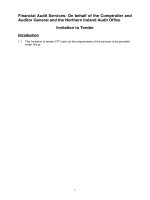
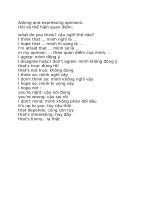
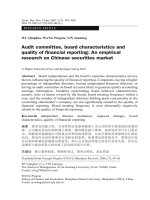
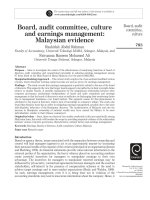
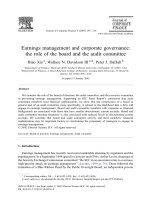
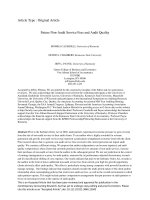
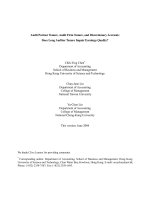

![chi et al - 2005 - mandatory audit-partner rotation, audit quality and market perception - evidence from taiwan [mapr]](https://media.store123doc.com/images/document/2015_01/06/medium_pap1420548067.jpg)